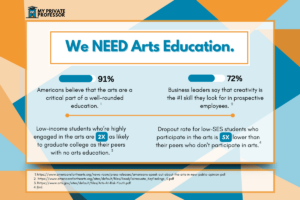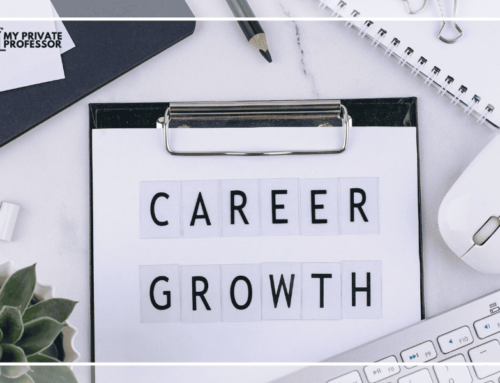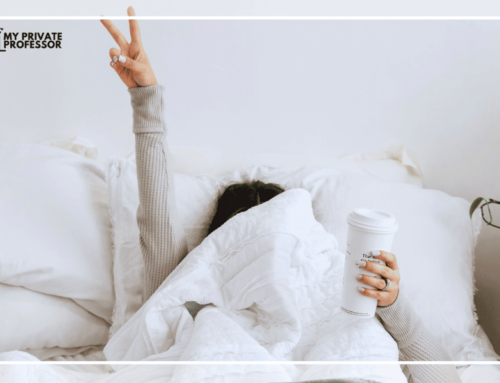Look around yourself. Whether you’re browsing social media, sitting in your local coffee shop, or riding the bus to work, just try it.
Look around and notice…all the different outfits people are wearing; how people style their hair; the color schemes people may or may not have purposefully crafted. This is called self-expression. And self-expression is part of a little thing we call art.
Where would we be without art? Who knows! But here are a few ways the arts play a critical role in my own life.
Art…
- Helps me find ways to express myself.
- Reassures me that there’s not one answer in life.
- Pushes me to think outside the bounds of “right” and “wrong”.
- Calms my brain and gives it a break from trying to “solve”.
- Inspires me to be courageous.
- Gives me the space to own myself and claim my inner voice.
Something important to remember is that the arts are simply another medium for learning, growth, and development. So, by that definition, I’d say it’s pretty clear that art belongs in education.
But as it stands, there’s a disconnect between the importance we place on arts education and the reality of the situation.
We value arts education—yet it’s declining…
According to the American Academy of Arts & Sciences, eighty-eight percent of Americans believe that arts education is a critical part of a balanced education.
In a 2016 national Americans for the Arts poll, nine in ten respondents said that students should receive an education in the arts at all grade levels.
And according to a 2019 Ipsos survey, most Americans (seventy nine percent) believe that arts education is just as important for society today as it was ten to fifteen years ago, and that it will continue to be an important part of society ten to fifteen years from now.
But reportedly, support for arts education has been on the decline.
It can be an easy solution to blame the pandemic, but even before COVID-19 reared its head, throughout the nation, arts education was declining.
In fact, the number of minutes that elementary school students had for arts education dropped from seventy to sixty-eight percent in the 2018-19 school year, according to K-12 Dive.
On top of this, the number of teachers in arts subjects has dropped in the past few years, according to school workforce statistics.
So clearly, there’s a problem.
How can arts education benefit students?
In order to collectively understand the importance of the arts in education, it’s important to look at the various ways in which art benefits students.
Enhancing social-emotional learning
In the past few years, researchers and educators have increasingly determined that social-emotional learning (SEL) is a powerful learning tool for students.
Seemingly, arts education is directly related to SEL components. That is, exposure to different types of art empowers and inspires students to engage with each other in ways that differ from how they do during more traditional classes.
Students can learn about various cultures, hear new perspectives, and as a result, broaden their ability to empathize and communicate.
Boosting academic achievement
It seems that sometimes people think that art doesn’t belong in an academic setting—and that maybe art classes take away from precious time that could be spent drilling in the quadratic formula.
However, arts education is actually directly linked to increased academic achievement. How do you like that?!
Arts Education Partnership conducted a meta-analysis, investigating the relationship between arts education and academic achievement. The study determined that:
- Students who studied music had higher achievement and proficiency in math than students who didn’t study music.
- Among students who studied music, reading and cognitive development increased, along with verbal SAT scores.
- Visual arts helped students better organize their writing.
Additionally, a 2016 study by the Solomon R. Guggenheim Museum found that, after analyzing and discussing paintings, third grade students had improved reasoning, hypothesizing, and communication abilities when it comes to looking at texts.
Research conducted in public schools in Maryland found that in courses where teachers integrate art with math, science, social studies, and other subjects, students had improvements in both reading and math.
Finally, a 2012 study “The Effects of High-Stakes Testing Policy on Arts Education”, found that withholding arts education to make more time for standardized testing subjects didn’t improve test scores. At some schools, it correlated with lower scores!
Here’s the thing: when students use all of their time and energy in a few specific ways (i.e. memorizing, writing, and reading), they can get burnt out.
Meanwhile, when students regularly exercise different brain muscles, they can be more present in all of their tasks. Because in this scenario, we’re giving students the chance to recharge instead of making them use the same brain muscles throughout the entire day.
Promoting empathy
School isn’t just for math. And it’s not just for writing, either.
Evidently, academic institutions have an obligation to not only students, but the world. And this obligation is to help students become their best selves (as much as possible). So that means that schools should also be helping students develop their emotional skills—such as empathy.
With empathy comes tolerance, understanding, and connection.
And the thing to remember is that humans are social creatures! We quite literally need each other in order to survive.
And, of course, empathy is an incredibly important skill to have in the workplace, one’s relationships, and social situations.
Notably, research shows that among adults, participation in art is linked to prosocial behavior.
Research suggests that art-based programs, through engaging students in creative endeavors can help students develop empathy.
That is, participating in these programs helps students develop their social, emotional, and academic learning. And research has pointed to a link between empathy and creativity.
Art inevitably exposes students to a whole myriad of ideas and perspectives, which in turn, promotes empathy and tolerance. As a result, students expand their potential for innovation and creativity. And they also become more motivated to connect with others and make a difference in society.
Reducing stress & depression
School, in itself, can be a lot. That’s just the truth. School brings what can seem like an endless number of tasks, responsibilities, and expectations. This inevitably can put a ton of pressure on students, which in turn, can cause mental exhaustion.
If you’re constantly thinking about the next thing you have to complete, it can be easy to become weighed down by stress and anxiety.
Research has found that art can decrease anxiety and depression, and reduce stress.
Research also shows that participating in art therapies can help relieve anxiety and stress. Something else that’s pretty cool: weekly singing is linked to reduced anxiety!
Having a better understanding of what’s happening in the brain during a) stress and b) art engagement can help explain this relationship.
When you’re stressed, your body tends to increase its production of cortisol, which is often called “the stress hormone”. Regularly having overly high levels of cortisol can be harmful to the body, causing symptoms such as headaches, fatigue, and difficulty concentrating.
Now here’s the other side of the coin: engaging in arts programs may reduce cortisol levels.
A 2016 study that looked at economically-disadvantaged preschoolers found that art programs (including music, dance, and visual arts) did, in fact, reduce cortisol levels in students. The researchers found that kids’ average cortisol levels were lower after arts classes compared to after homeroom periods.
Another study that looked at the relationship between making art and cortisol levels found that while making art, seventy-five percent of participants had decreased cortisol levels.
When students are in a better headspace, they’re more equipped to pay attention in class, retain information, and thus will have better learning outcomes.
Arts education is particularly valuable for low SES students
Oten, compared to their peers, students from low SES backgrounds are at higher risk for dropping out of school.
Research has long shown that art can help combat this risk, as arts education is linked to various benefits for these students.
But unfortunately, it’s these students who are less likely to have access to arts education. A federal government report found that schools designated under No Child Left Behind as needing improvement, and schools with more minority students, were more likely to have reduced time spent on arts education.
A report by the National Endowment for the Arts found that students from low SES backgrounds who have a history of involvement in the arts have better long-term academic, occupational, and social outcomes than their peers.
The report also demonstrated that a high involvement in the arts was a motivational factor for students to attend college. Additionally, that high involvement increased the likelihood that students would apply to a moderately or highly selective school.
Low SES students who had experience in the arts were found to be three times as likely to earn a bachelor’s degree than their peers.
A 2009 study, “Doing Well and Doing Good by Doing Art” followed 12,000 students and tracked their academic progress from ages eighteen to twenty-six. The researchers found that students from low SES backgrounds who engaged in the arts had significantly higher college attendance rates, college grades, and better job opportunities than their peers.
The study also found that English Language Learner (ELL) students showed improved academic achievement in schools that offered more arts education. Furthermore, after attending these schools, these students were significantly more likely to pursue a bachelor’s degree at age twenty.
Providing low SES students with the opportunity to engage in art, then, is a powerful way to boost educational outcomes.
Final thoughts
Fortunately, schools are finding ways to implement art into the classroom. For instance, Pierre Elliott Trudeau Elementary School uses music to supplement teaching.
In the school, kids get to listen to music and engage with one another—this supports their language development. The school has found that as a result, students are inspired, creative, and focused when they sit down to work.
Seemingly, sometimes the one thing that motivates kids to show up at school is knowing that they get to engage in these programs. (For me, this was the percussion ensemble).
If art programs improve students’ wellbeing, reduce their stress, and inspire creativity, wouldn’t it be fair to conclude that art can also boost student motivation to be present in their classes about which they may have had some apathy?
And considering all the research that’s screaming, the arts improve student outcomes and achievement, it seems like a no-brainer. Don’t we want to build up the next generations to have optimal creative skills, critical thinking, and empathy?








